Masterpiece Story: Portrait of Madeleine by Marie-Guillemine Benoist
What is the message behind Marie-Guillemine Benoist’s Portrait of Madeleine? The history and tradition behind this 1800 painting might explain...
Jimena Escoto 16 February 2025
26 January 2025 min Read
In a Neoclassicist masterpiece painted on the eve of the French Revolution, Jacques-Louis David depicts the beginning of an epic Roman story in The Oath of the Horatii. Patriotism and masculine self sacrifice are shown in a passionate decision that sets the fate of a family and nation for better and for worse. In this article, we will see the drama of both stories unfold as we explore David’s masterpiece.
If you have ever heard the phrase “a picture is worth a thousand words,” you will better understand its meaning today as we discover a Roman epic embodied within The Oath of the Horatii by Jacques-Louis David – a true icon of Neoclassical art.
In preparation, David turned to the writings of Roman historian Titus Livius, or as he is known in English, Livy, to depict an act of patriotism that ultimately settled the conflict between Rome and the nearby city of Alba Longa. Attempting to avoid needless bloodshed, the kings of the cities agreed to send fighters on behalf of their people to fight to the death, with the survivors claiming victory for their city.
The three brothers of the Horatii family volunteered to fight on behalf of Rome. They faced off against their cousins, the three brothers of the Curiatii family, fighting for the people of Alba Longa.
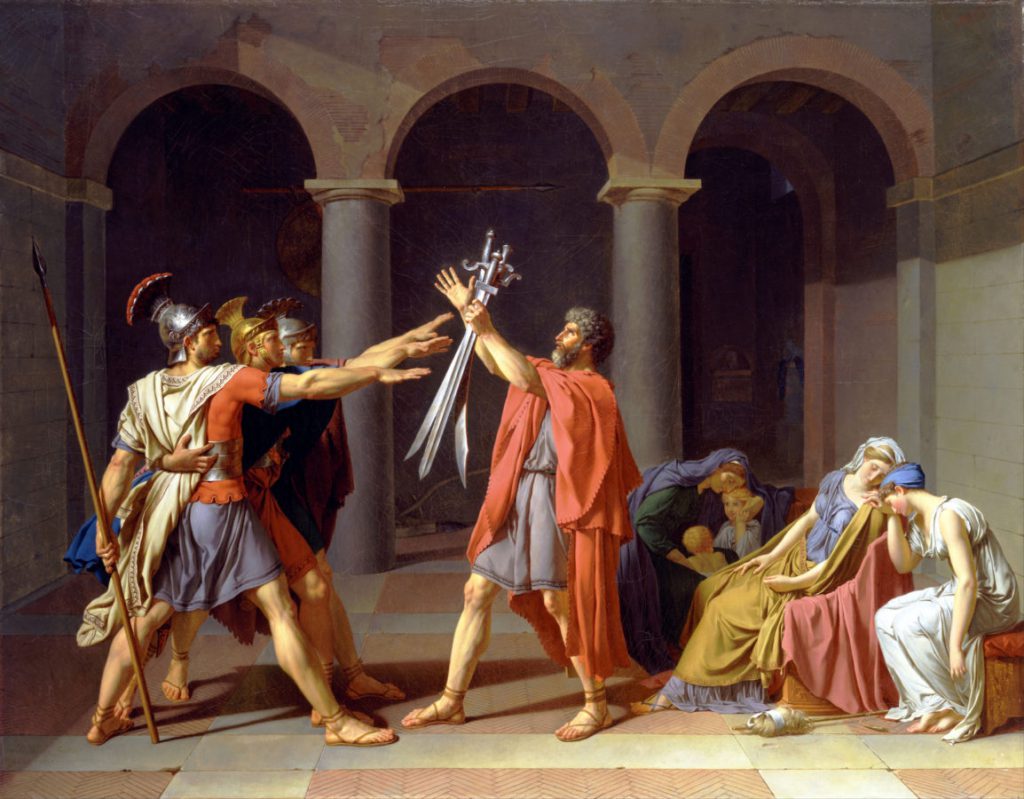
Jacques-Louis David, The Oath of the Horatii, 1786, Toledo Museum of Art, Toledo, OH, USA.
There are two versions of The Oath of the Horatii, the original resides in Paris’ Musée du Louvre and a replica copy requested by the influential Comte de Vaudreuil in 1786, which resides in the Toledo Museum of Art in Ohio, USA. The original painting was commissioned by Charles-Claude Flahaut de la Billaderie, the assistant of King Louis XVI, five years before the coming French Revolution. In The Oath of the Horatii, Jacques-Louis David showcases the full force of Neoclassicism through striking composition, tempered colors, and restrained emotion.
The composition is apparent as the painting has been divided into three sections. The Horatii brothers are straight and angled in posture with their arms stretched out in front, a commanding gesture, in the left third of the painting. The women, the Horatii sisters, are slumped over in the right third of the painting. The family’s father is squarely in the middle, framed by the pillars of the noble house.
The masculine forms of the men are contrasted neatly by the rounded forms of the sisters and children. This pattern is also echoed by the straight columns that frame and divide the painting into thirds with rounded archways between them. All together, their shapes lead our eyes to the clear focal point: the weapons held up by the father, the pinnacle of the composition.
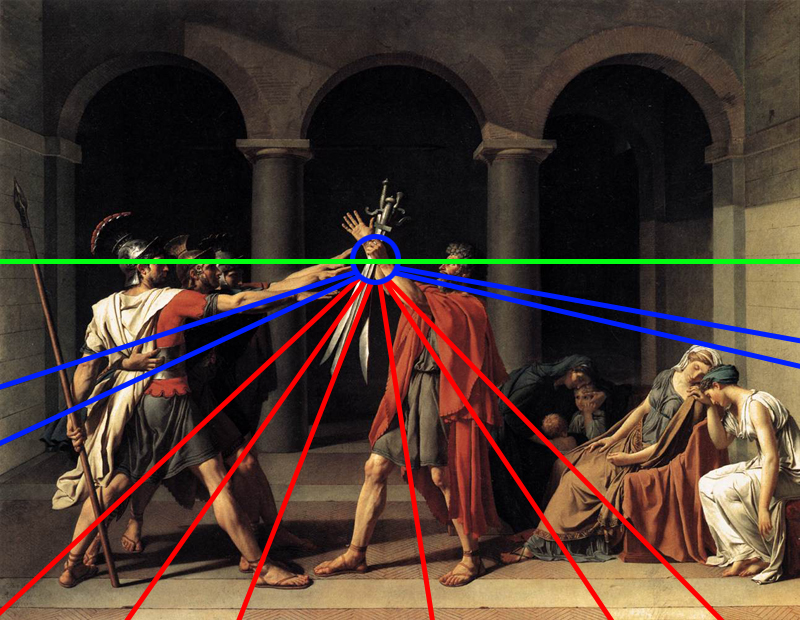
Compositional structure in Jacques-Louis David, The Oath of the Horatii, c. 1784, Louvre, Paris, France.
In purposeful bravery, the brothers pledge their lives to fight on behalf of their fatherland, spare the lives of many, and unite the two cities under one rule. King Louis XVI of France desired this painting to incite loyalty to the country from his people. Let’s look at the foreshadowed drama that follows their determination to fight. Something that excites me about Neoclassical art is the more profound emotion bound within the composition. It is evident through color and expression.
As he holds up the swords to give to his sons, the father’s head is tilted upward, a common position of looking toward salvation. His brow is furled, and his mouth is partly open. He expresses emotions of both worry and hope.
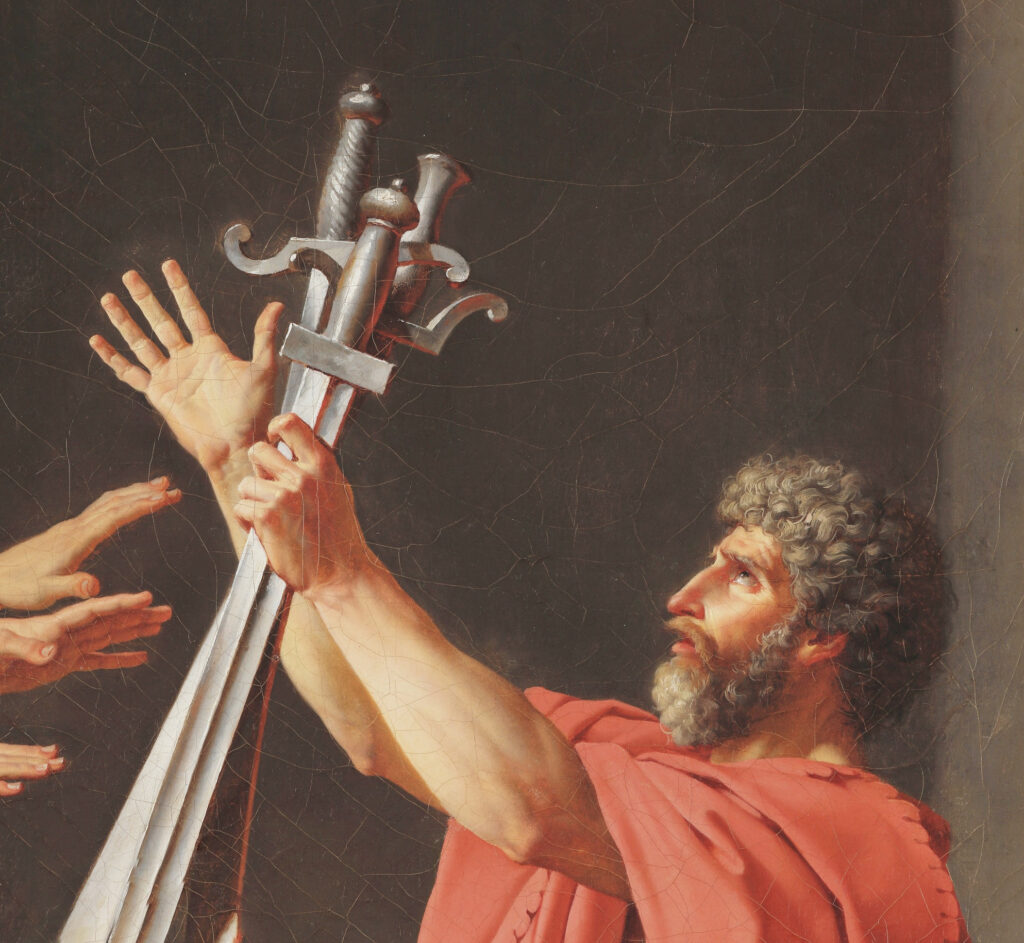
Jacques-Louis David, The Oath of the Horatii, 1786, Toledo Museum of Art, Toledo, OH, USA. Detail.
In contrast to their father and sisters, the Horatii brothers’ eyes are fixed, their faces filled with unflinching earnestness, giving an air of stoic duty. Their straightened arms complete their masculine, statuesque frames. The two brothers in the background lean forward, presenting an aggressive quality to their actions. However, they are not free from emotion completely. In a beautiful detail, David includes the brothers’ fierce embrace during their oath swearing. This embrace communicates a strong camaraderie felt by the brothers towards each other. They are bound to one another by patriotic duty while also demonstrating a feeling of urgency to their situation and a desire to hold close their literal brothers in arms – a powerful foreshadowing of their yet unknown fate.
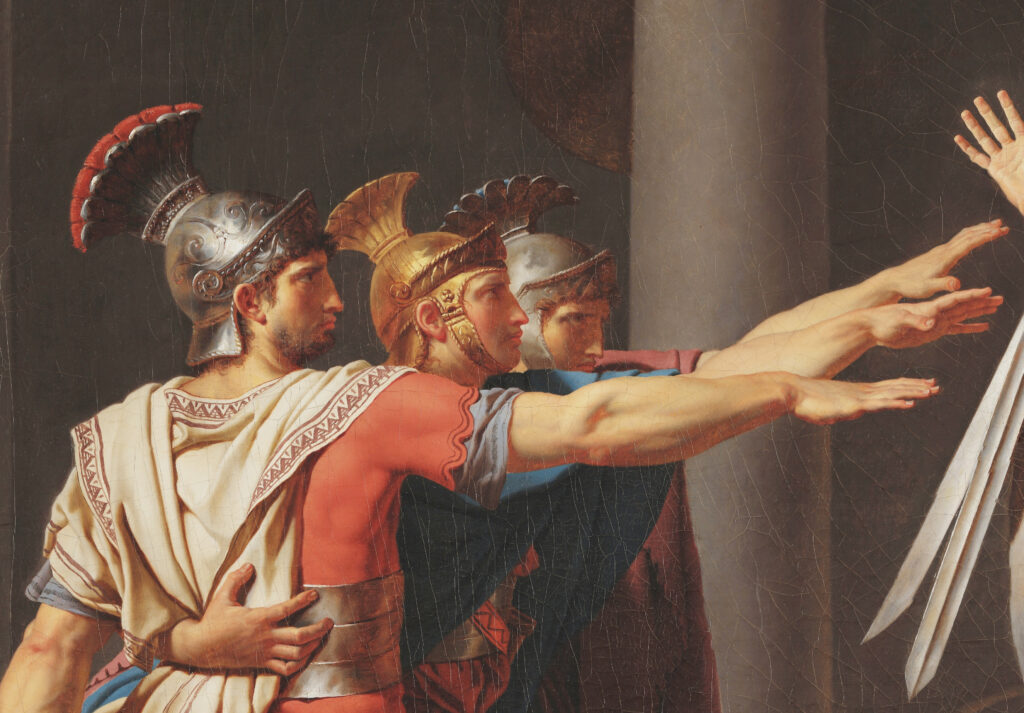
Jacques-Louis David, The Oath of the Horatii, 1786, Toledo Museum of Art, Toledo, OH, USA. Detail.
The most unbound emotion in the painting comes through the sisters and their children. They are slumped over in sorrow because of what the oath being taken signals. In the story, the sisters are married to the Curiatii brothers, so they will mourn whatever the result of the fight. Either they lose their brothers, or they lose their husbands. They are positioned in the painting almost as a reflection of the action taking place, a tearful effect of the patriotic decision. Even if it spares a nation of people from death, they will lose those closest to them.
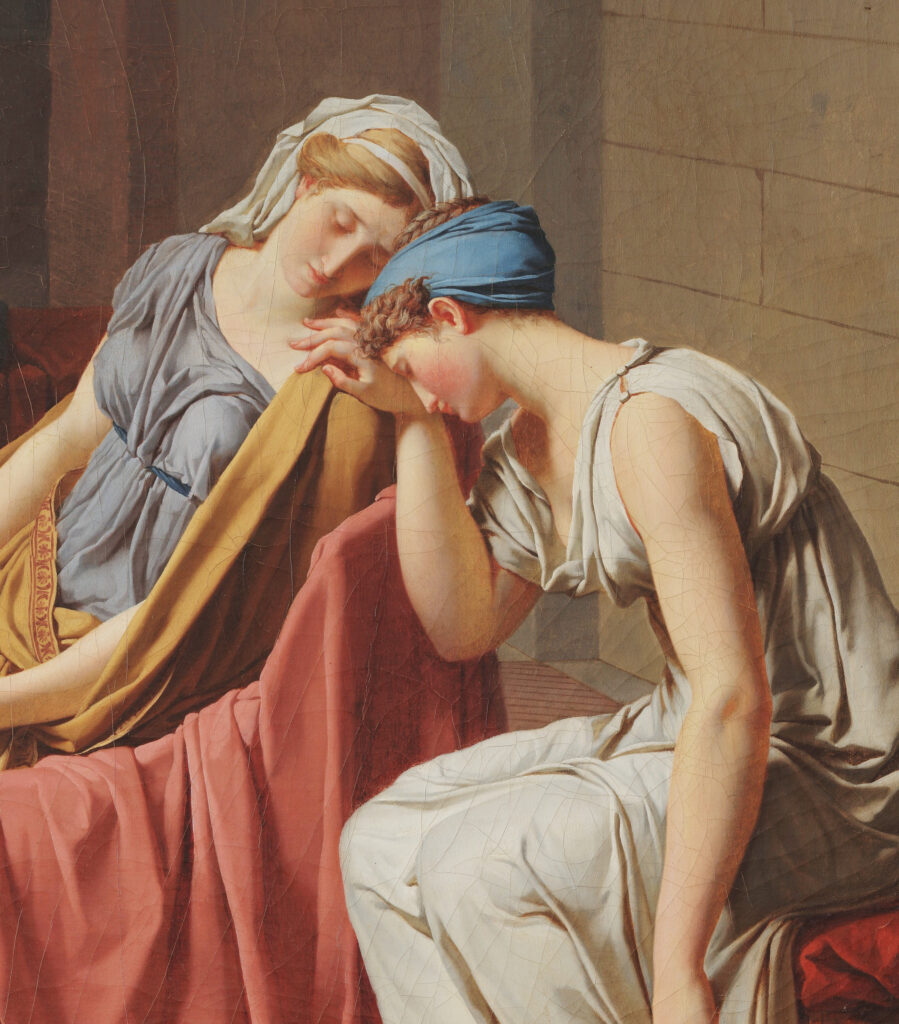
Jacques-Louis David, The Oath of the Horatii, 1786, Toledo Museum of Art, Toledo, OH, USA. Detail.
For Jacques-Louis David, The Oath of the Horatii did not see uninterrupted success. The painting, like the oath depicted in it, was something of a signal of the incoming war in 1789. Soon after the painting’s creation, the blood-slicked jaws of the French Revolution tore into the country. In the very definition of the word “passion,” you will read the words “strong” and “uncontrollable” used. This also defines the fate of both the Horatii brothers and Jacques-Louis David.
In the story, when the brothers meet the Curiatii to fight, two Horatii brothers are immediately slain. Now outnumbered, the last Horatii brother fled, leaving behind the brothers who once embraced him – but his flight did not last for long, as he had used his retreat as a ruse. He turned back to the fight, now able to cut through the Curiatti brothers one at a time. The last Horatii brother brought victory to the people of Rome. Upon his return, his sister, seeing the cloak she had made for her husband now draped over her victorious brother, fell and wept. Angry at her lament for the fallen husband despite the deaths of two of her brothers, the victorious Horatii brother plunged his weapon into his sister, killing her. The city he had just spared through his victory now stood before him as his accusers, and he faced trial for killing his sister, a Roman.
Like the last Horatii brother, Jacques-Louis David was also accused by the country he loved and rallied through his masterpiece. He was eventually imprisoned for his part in voting to behead the very King who commissioned The Oath of the Horatii.

Jacques-Louis David, The Oath of the Horatii, 1786, Toledo Museum of Art, Toledo, OH, USA.
Jacques-Louis David was a masterful painter – perhaps the greatest painter of the Neoclassical era. His works were monumental and, as seen in The Oath of the Horatii, had unimaginable influence on people. I believe that the true power of art is found and continues to be evident through the people who witness it and receive insight from it. One face from the painting I have not previously discussed in this article – is that of the child who refused to look away. Perhaps it is through the eyes of this child, who chose to witness the event that would change the lives of the Horatii and Curiatii families, that Jacques-Louis David had intended for us to see and remember.
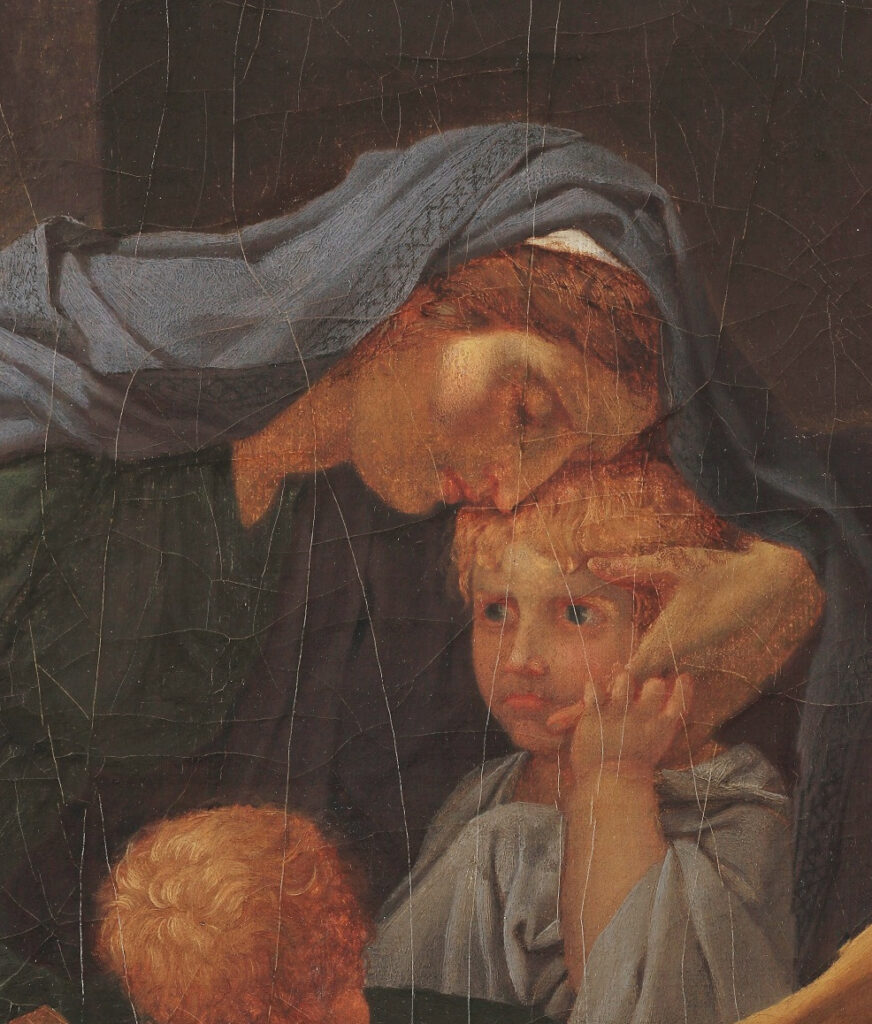
Jacques-Louis David, The Oath of the Horatii, 1786, Toledo Museum of Art, Toledo, OH, USA. Detail.
Jacques-Louis David lived an exciting life that gave him a well-rounded insight into war and the need for peace within a nation. In another masterpiece, The Intervention of the Sabine Women, David flips the narrative seen in The Oath of the Horatii. Rather than the women mourning the deadly conflict that is to come, they are the ones who end it. It displays what Livy said about the account, “…strength by harmony.” Learn more about the strong heroine who helped protect her people and other Neoclassical masterpieces using our DailyArt app!
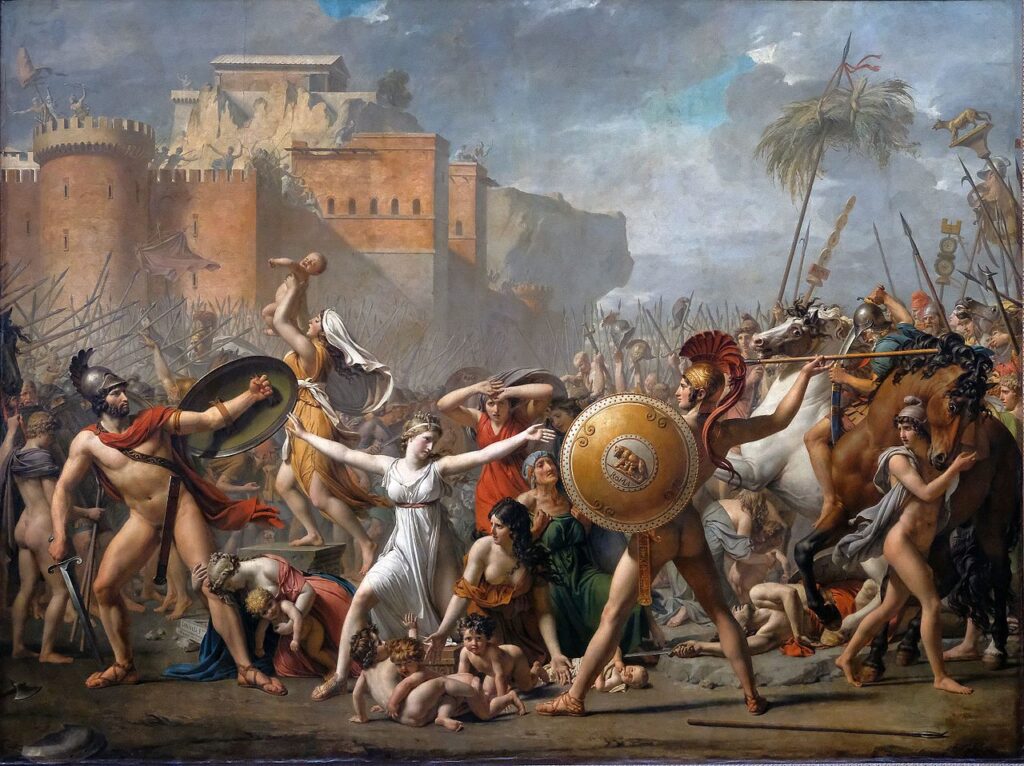
Jacques-Louis David, The Intervention of the Sabine Women, 1799, Louvre, Paris, France.
The Oath of the Horatii, Google Arts & Culture. Retrieved 19 Nov. 2023.
Pierre Corneille, Corneille’s Horace. Retrieved 19 Nov., 2023.
The Oath of the Horatii, Wikipedia. Retrieved 19 Nov. 2023.
Titus Livius (Livy), The History of Rome, Book 1, Ed. by Benjamin Oliver Foster, Retrieved. 19 Nov. 2023.
Horatii and Curiatii, “Britannica”. Retrieved 19 Nov. 2023.
Jacques-Louis David, “Britannica”. Retrieved 19 Nov. 2023.
DailyArt Magazine needs your support. Every contribution, however big or small, is very valuable for our future. Thanks to it, we will be able to sustain and grow the Magazine. Thank you for your help!